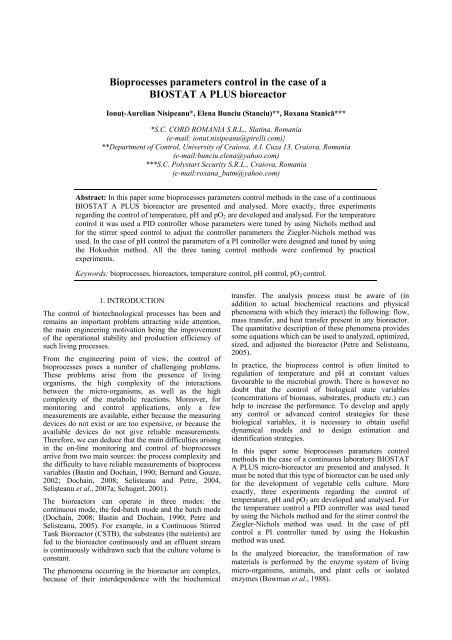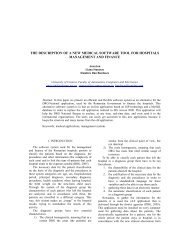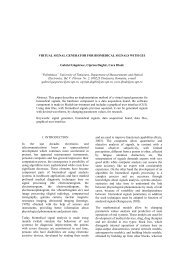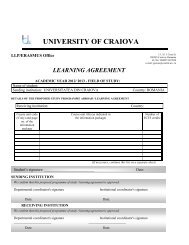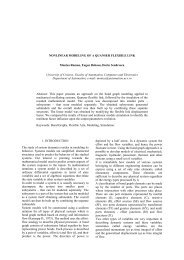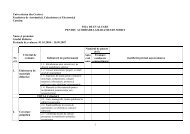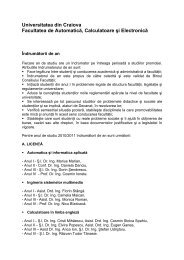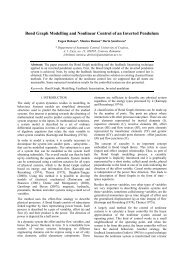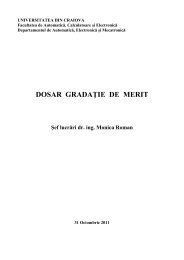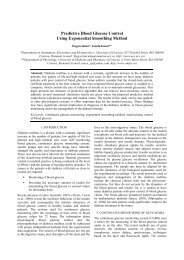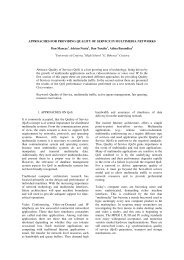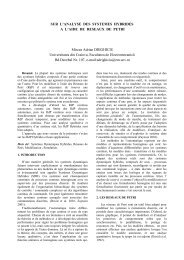Bioprocesses parameters control in the case of a BIOSTAT A PLUS ...
Bioprocesses parameters control in the case of a BIOSTAT A PLUS ...
Bioprocesses parameters control in the case of a BIOSTAT A PLUS ...
Create successful ePaper yourself
Turn your PDF publications into a flip-book with our unique Google optimized e-Paper software.
<strong>Bioprocesses</strong> <strong>parameters</strong> <strong>control</strong> <strong>in</strong> <strong>the</strong> <strong>case</strong> <strong>of</strong> a<br />
<strong>BIOSTAT</strong> A <strong>PLUS</strong> bioreactor<br />
Ionuţ-Aurelian Nisipeanu*, Elena Bunciu (Stanciu)**, Roxana Stanică***<br />
*S.C. CORD ROMANIA S.R.L., Slat<strong>in</strong>a, Romania<br />
(e-mail: ionut.nisipeanu@pirelli.com)}<br />
**Department <strong>of</strong> Control, University <strong>of</strong> Craiova, A.I. Cuza 13, Craiova, Romania<br />
(e-mail:bunciu.elena@yahoo.com)<br />
***S.C. Polystart Security S.R.L., Craiova, Romania<br />
(e-mail:roxana_batm@yahoo.com)<br />
Abstract: In this paper some bioprocesses <strong>parameters</strong> <strong>control</strong> methods <strong>in</strong> <strong>the</strong> <strong>case</strong> <strong>of</strong> a cont<strong>in</strong>uous<br />
<strong>BIOSTAT</strong> A <strong>PLUS</strong> bioreactor are presented and analysed. More exactly, three experiments<br />
regard<strong>in</strong>g <strong>the</strong> <strong>control</strong> <strong>of</strong> temperature, pH and pO 2 are developed and analysed. For <strong>the</strong> temperature<br />
<strong>control</strong> it was used a PID <strong>control</strong>ler whose <strong>parameters</strong> were tuned by us<strong>in</strong>g Nichols method and<br />
for <strong>the</strong> stirrer speed <strong>control</strong> to adjust <strong>the</strong> <strong>control</strong>ler <strong>parameters</strong> <strong>the</strong> Ziegler-Nichols method was<br />
used. In <strong>the</strong> <strong>case</strong> <strong>of</strong> pH <strong>control</strong> <strong>the</strong> <strong>parameters</strong> <strong>of</strong> a PI <strong>control</strong>ler were designed and tuned by us<strong>in</strong>g<br />
<strong>the</strong> Hokush<strong>in</strong> method. All <strong>the</strong> three tun<strong>in</strong>g <strong>control</strong> methods were confirmed by practical<br />
experiments.<br />
Keywords: bioprocesses, bioreactors, temperature <strong>control</strong>, pH <strong>control</strong>, pO 2 <strong>control</strong>.<br />
1. INTRODUCTION<br />
The <strong>control</strong> <strong>of</strong> biotechnological processes has been and<br />
rema<strong>in</strong>s an important problem attract<strong>in</strong>g wide attention,<br />
<strong>the</strong> ma<strong>in</strong> eng<strong>in</strong>eer<strong>in</strong>g motivation be<strong>in</strong>g <strong>the</strong> improvement<br />
<strong>of</strong> <strong>the</strong> operational stability and production efficiency <strong>of</strong><br />
such liv<strong>in</strong>g processes.<br />
From <strong>the</strong> eng<strong>in</strong>eer<strong>in</strong>g po<strong>in</strong>t <strong>of</strong> view, <strong>the</strong> <strong>control</strong> <strong>of</strong><br />
bioprocesses poses a number <strong>of</strong> challeng<strong>in</strong>g problems.<br />
These problems arise from <strong>the</strong> presence <strong>of</strong> liv<strong>in</strong>g<br />
organisms, <strong>the</strong> high complexity <strong>of</strong> <strong>the</strong> <strong>in</strong>teractions<br />
between <strong>the</strong> micro-organisms, as well as <strong>the</strong> high<br />
complexity <strong>of</strong> <strong>the</strong> metabolic reactions. Moreover, for<br />
monitor<strong>in</strong>g and <strong>control</strong> applications, only a few<br />
measurements are available, ei<strong>the</strong>r because <strong>the</strong> measur<strong>in</strong>g<br />
devices do not exist or are too expensive, or because <strong>the</strong><br />
available devices do not give reliable measurements.<br />
Therefore, we can deduce that <strong>the</strong> ma<strong>in</strong> difficulties aris<strong>in</strong>g<br />
<strong>in</strong> <strong>the</strong> on-l<strong>in</strong>e monitor<strong>in</strong>g and <strong>control</strong> <strong>of</strong> bioprocesses<br />
arrive from two ma<strong>in</strong> sources: <strong>the</strong> process complexity and<br />
<strong>the</strong> difficulty to have reliable measurements <strong>of</strong> bioprocess<br />
variables (Bast<strong>in</strong> and Docha<strong>in</strong>, 1990; Bernard and Gouze,<br />
2002; Docha<strong>in</strong>, 2008; Selisteanu and Petre, 2004,<br />
Selişteanu et al., 2007a; Schugerl, 2001).<br />
The bioreactors can operate <strong>in</strong> three modes: <strong>the</strong><br />
cont<strong>in</strong>uous mode, <strong>the</strong> fed-batch mode and <strong>the</strong> batch mode<br />
(Docha<strong>in</strong>, 2008; Bast<strong>in</strong> and Docha<strong>in</strong>, 1990; Petre and<br />
Selisteanu, 2005). For example, <strong>in</strong> a Cont<strong>in</strong>uous Stirred<br />
Tank Bioreactor (CSTB), <strong>the</strong> substrates (<strong>the</strong> nutrients) are<br />
fed to <strong>the</strong> bioreactor cont<strong>in</strong>uously and an effluent stream<br />
is cont<strong>in</strong>uously withdrawn such that <strong>the</strong> culture volume is<br />
constant.<br />
The phenomena occurr<strong>in</strong>g <strong>in</strong> <strong>the</strong> bioreactor are complex,<br />
because <strong>of</strong> <strong>the</strong>ir <strong>in</strong>terdependence with <strong>the</strong> biochemical<br />
transfer. The analysis process must be aware <strong>of</strong> (<strong>in</strong><br />
addition to actual biochemical reactions and physical<br />
phenomena with which <strong>the</strong>y <strong>in</strong>teract) <strong>the</strong> follow<strong>in</strong>g: flow,<br />
mass transfer, and heat transfer present <strong>in</strong> any bioreactor.<br />
The quantitative description <strong>of</strong> <strong>the</strong>se phenomena provides<br />
some equations which can be used to analyzed, optimized,<br />
sized, and adjusted <strong>the</strong> bioreactor (Petre and Selisteanu,<br />
2005).<br />
In practice, <strong>the</strong> bioprocess <strong>control</strong> is <strong>of</strong>ten limited to<br />
regulation <strong>of</strong> temperature and pH at constant values<br />
favourable to <strong>the</strong> microbial growth. There is however no<br />
doubt that <strong>the</strong> <strong>control</strong> <strong>of</strong> biological state variables<br />
(concentrations <strong>of</strong> biomass, substrates, products etc.) can<br />
help to <strong>in</strong>crease <strong>the</strong> performance. To develop and apply<br />
any <strong>control</strong> or advanced <strong>control</strong> strategies for <strong>the</strong>se<br />
biological variables, it is necessary to obta<strong>in</strong> useful<br />
dynamical models and to design estimation and<br />
identification strategies.<br />
In this paper some bioprocesses <strong>parameters</strong> <strong>control</strong><br />
methods <strong>in</strong> <strong>the</strong> <strong>case</strong> <strong>of</strong> a cont<strong>in</strong>uous laboratory <strong>BIOSTAT</strong><br />
A <strong>PLUS</strong> micro-bioreactor are presented and analysed. It<br />
must be noted that this type <strong>of</strong> bioreactor can be used only<br />
for <strong>the</strong> development <strong>of</strong> vegetable cells culture. More<br />
exactly, three experiments regard<strong>in</strong>g <strong>the</strong> <strong>control</strong> <strong>of</strong><br />
temperature, pH and pO 2 are developed and analysed. For<br />
<strong>the</strong> temperature <strong>control</strong> a PID <strong>control</strong>ler was used tuned<br />
by us<strong>in</strong>g <strong>the</strong> Nichols method and for <strong>the</strong> stirrer <strong>control</strong> <strong>the</strong><br />
Ziegler-Nichols method was used. In <strong>the</strong> <strong>case</strong> <strong>of</strong> pH<br />
<strong>control</strong> a PI <strong>control</strong>ler tuned by us<strong>in</strong>g <strong>the</strong> Hokush<strong>in</strong><br />
method was used.<br />
In <strong>the</strong> analyzed bioreactor, <strong>the</strong> transformation <strong>of</strong> raw<br />
materials is performed by <strong>the</strong> enzyme system <strong>of</strong> liv<strong>in</strong>g<br />
micro-organisms, animals, and plant cells or isolated<br />
enzymes (Bowman et al., 1988).
The success <strong>of</strong> biotechnological experiments depends on<br />
<strong>the</strong> optimal growth conditions <strong>of</strong> <strong>the</strong> micro-organisms <strong>in</strong><br />
<strong>the</strong> created bioreactor. The cells are constantly struggl<strong>in</strong>g<br />
with changes <strong>in</strong> <strong>the</strong> culture, <strong>in</strong> order to obta<strong>in</strong> and<br />
ma<strong>in</strong>ta<strong>in</strong> optimal growth conditions. (Petre, 2008).<br />
The bioreactor <strong>control</strong> must ensure <strong>the</strong> cont<strong>in</strong>uous supply<br />
<strong>of</strong> cells with appropriate resources used for growth or<br />
production <strong>of</strong> metabolites, ensur<strong>in</strong>g also optimum values<br />
for pH, temperature, substrate concentration, m<strong>in</strong>eral salts<br />
concentration, growth factors and oxygen concentration<br />
(Petre and Selisteanu, 2005).<br />
The paper is organized as follows. In Section 2 <strong>the</strong><br />
technical features <strong>of</strong> <strong>the</strong> <strong>BIOSTAT</strong> A <strong>PLUS</strong> bioreactor<br />
are presented. Section 3 conta<strong>in</strong>s some experiments<br />
regard<strong>in</strong>g <strong>the</strong> <strong>control</strong> <strong>of</strong> <strong>the</strong> temperature, section 4 details<br />
<strong>the</strong> problems regard<strong>in</strong>g <strong>the</strong> <strong>control</strong> <strong>of</strong> <strong>the</strong> stirrer speed and<br />
section 5 deals with pH and pO 2 <strong>control</strong>.<br />
2. THE TECHNICAL FEATURES OF <strong>BIOSTAT</strong> A<br />
<strong>PLUS</strong> BIOREACTOR<br />
The reactor used <strong>in</strong> this paper is a Biostat A Plus<br />
bioreactor, a product from Sartorius Sepadim Company.<br />
In Fig. 1 <strong>the</strong> entire package Biostat A Plus bioreactor is<br />
presented. The equipment conta<strong>in</strong>s three components: an<br />
autoclaved bioreactor, a <strong>control</strong> unit and a s<strong>of</strong>tware<br />
application that can <strong>control</strong> different <strong>parameters</strong> like<br />
temperature, pH, pO 2 , stirrer velocity or different gas<br />
flows (<strong>BIOSTAT</strong>, 2006).<br />
Fig. 1. Biostat A Plus Bioreactor (<strong>BIOSTAT</strong>, 2006).<br />
The communication between <strong>the</strong> <strong>control</strong> unit and <strong>the</strong><br />
laptop that conta<strong>in</strong>s <strong>the</strong> microDCU MFCS/DA s<strong>of</strong>tware<br />
(Multi Fermenter Control System – Data Acquisition) is<br />
realised by us<strong>in</strong>g <strong>the</strong> E<strong>the</strong>rnet TCP/IP protocol<br />
(<strong>BIOSTAT</strong>, 2006). E<strong>the</strong>rnet is a broadcast network<br />
designed for local area networks. E<strong>the</strong>rnet became <strong>the</strong><br />
most popular technology based on Layer 2 (can take<br />
forward<strong>in</strong>g decisions based on MAC address) because it<br />
is best suited for <strong>the</strong> occasional network traffic (Iancu,<br />
2004).<br />
2.1 Bioreactor description<br />
The culture vessel used for experiments has a volume <strong>of</strong> 5<br />
litres and it is made <strong>of</strong> borosilicate glass that can be<br />
heated up to approximately 80°C by an electrical blanket<br />
(<strong>BIOSTAT</strong>, 2006).<br />
Autoclave sterilization <strong>of</strong> <strong>the</strong> vessel and its components is<br />
done at a temperature <strong>of</strong> 121°C (<strong>BIOSTAT</strong>, 2006).<br />
The vessel lid is made <strong>of</strong> sta<strong>in</strong>less steel and has holes <strong>of</strong><br />
different diameters for <strong>in</strong>troduc<strong>in</strong>g <strong>the</strong> stirrer, tubes for<br />
<strong>in</strong>troduc<strong>in</strong>g <strong>the</strong> substances and probes for pH, pO 2 ,<br />
temperature, antifoam/level measurement (<strong>BIOSTAT</strong>,<br />
2006).<br />
The homogeneity <strong>of</strong> culture is realised by <strong>the</strong> stirrer and<br />
consists <strong>in</strong> a drive that rotates an arbour. A helicoidally<br />
paddle is attached to <strong>the</strong> arbour. All components that are<br />
<strong>in</strong> direct contact with <strong>the</strong> culture are made <strong>of</strong> sta<strong>in</strong>less<br />
steel (<strong>BIOSTAT</strong>, 2006).<br />
The stirrer <strong>of</strong> <strong>the</strong> cell culture version bioreactor consists<br />
<strong>of</strong> three coaxial segments and ensures a slide and<br />
effective mixture (<strong>BIOSTAT</strong>, 2006).<br />
In <strong>the</strong> bioreactor’s field <strong>the</strong> temperature can be <strong>control</strong>led<br />
<strong>in</strong> several ways. For example, <strong>in</strong> <strong>the</strong> <strong>case</strong> <strong>of</strong> double-wall<br />
vessels <strong>the</strong> temperature is <strong>control</strong>led by a system <strong>of</strong><br />
serpent<strong>in</strong>es through which <strong>the</strong> water runs (<strong>BIOSTAT</strong>,<br />
2006).<br />
In <strong>the</strong> <strong>case</strong> <strong>of</strong> <strong>the</strong> presented bioreactor with a s<strong>in</strong>gle wall<br />
vessel, <strong>the</strong> <strong>control</strong> <strong>of</strong> temperature is done with <strong>the</strong> help <strong>of</strong><br />
a heat<strong>in</strong>g blanket that consists <strong>of</strong> an electrical serpent<strong>in</strong>e<br />
covered with a layer <strong>of</strong> silicone rubber foam. When <strong>the</strong><br />
temperature <strong>in</strong> <strong>the</strong> vessel decreases bellow <strong>the</strong> reference<br />
value, <strong>the</strong> blanket starts heat<strong>in</strong>g. The major disadvantage<br />
is <strong>the</strong> necessity <strong>of</strong> a separated system for cool<strong>in</strong>g <strong>the</strong><br />
bioreactor (<strong>BIOSTAT</strong>, 2006).<br />
2.2 Control Unit<br />
The <strong>control</strong> unit is characterized by an <strong>in</strong>tegrated <strong>control</strong><br />
system, <strong>in</strong>tegrated pumps, gas flow <strong>control</strong>lers, <strong>control</strong> for<br />
pH/DO and foam/level (<strong>BIOSTAT</strong>, 2006).<br />
For <strong>the</strong> <strong>control</strong> unit it is necessary to use an external<br />
computer. This also <strong>of</strong>fers <strong>the</strong> possibility <strong>of</strong> a touch panel<br />
attachment and development <strong>of</strong> s<strong>of</strong>tware for manag<strong>in</strong>g /<br />
monitor<strong>in</strong>g process (<strong>BIOSTAT</strong>, 2006).<br />
In <strong>the</strong> frontal part <strong>of</strong> <strong>the</strong> unit <strong>the</strong>e exist three peristaltic<br />
pumps that can be l<strong>in</strong>ked to <strong>the</strong> acid, base and<br />
antifoam/level bottle (<strong>BIOSTAT</strong>, 2006).<br />
3. TEMPERATURE CONTROL<br />
To <strong>control</strong> <strong>the</strong> process temperature, first we must<br />
determ<strong>in</strong>e <strong>the</strong> process model, <strong>in</strong> particular <strong>the</strong> transfer<br />
function that describes this process. To do this we<br />
developed an experiment, more exactly a bioreactor<br />
heat<strong>in</strong>g test that gives us <strong>the</strong> possibility to identify <strong>the</strong><br />
<strong>parameters</strong> <strong>of</strong> <strong>the</strong> transfer function. The dynamics <strong>of</strong> <strong>the</strong><br />
system is studied by us<strong>in</strong>g signal acquisition from <strong>the</strong><br />
temperature sensor <strong>in</strong>side <strong>the</strong> vessel and from its<br />
graphical representation by us<strong>in</strong>g <strong>the</strong> micro-DCU.<br />
The <strong>the</strong>rmodynamics <strong>the</strong>ory claims that <strong>the</strong> heat<strong>in</strong>g<br />
process tak<strong>in</strong>g place <strong>in</strong>side an enclosure can be
approximated by a first order transfer function with <strong>the</strong><br />
<strong>in</strong>put voltage and output power <strong>of</strong> <strong>the</strong> mantle represented<br />
by <strong>the</strong> temperature <strong>in</strong>side <strong>the</strong> vessel.<br />
The transfer function, denoted G h<br />
(s)<br />
, can be expressed<br />
by <strong>the</strong> follow<strong>in</strong>g equation (Mar<strong>in</strong> 2004):<br />
−τ⋅s<br />
Y ( s)<br />
K ⋅ e<br />
Gh ( s)<br />
= = . (1)<br />
U ( s)<br />
T ⋅ s + 1<br />
The value <strong>of</strong> <strong>the</strong> ga<strong>in</strong>, K, is obta<strong>in</strong>ed by measur<strong>in</strong>g <strong>the</strong><br />
value Δ u and <strong>the</strong> value [ y( ∞ ) − yst<br />
(0)]<br />
correspond<strong>in</strong>g to<br />
graphic segments <strong>in</strong> Fig. 2 (Mar<strong>in</strong>, 2004). Then, K is<br />
given by:<br />
K =<br />
[ y( ∞) − y ( )]<br />
Δu<br />
st<br />
0 . (2)<br />
Fig. 2. The step response <strong>of</strong> a first order aperiodic element<br />
with time delay (Mar<strong>in</strong>, 2004).<br />
A method for estimat<strong>in</strong>g <strong>the</strong> time constant T is <strong>the</strong> tangent<br />
method (Mar<strong>in</strong>, 2004). In <strong>the</strong> <strong>in</strong>itial po<strong>in</strong>t B, a tangent can<br />
be drown to <strong>the</strong> response that <strong>in</strong>tersects <strong>the</strong> y (∞)<br />
axis <strong>in</strong><br />
<strong>the</strong> po<strong>in</strong>t C. DE is <strong>the</strong> projection <strong>of</strong> segment BC on <strong>the</strong><br />
time axis and represents <strong>the</strong> time constant T (Mar<strong>in</strong> 2004).<br />
In Fig. 3 <strong>the</strong> experimental results obta<strong>in</strong>ed for a reference<br />
value <strong>of</strong> 35°C and an <strong>in</strong>itial value <strong>in</strong>side <strong>the</strong> culture vessel<br />
<strong>of</strong> 25.6°C are represented. The duration <strong>of</strong> <strong>the</strong> experiment<br />
was 440 m<strong>in</strong>utes. We can observe that <strong>the</strong> process is a<br />
slow one, hav<strong>in</strong>g a high time constant and time delay. The<br />
steady state error is also higher and for that reason it is<br />
necessary to design a <strong>control</strong>ler.<br />
Us<strong>in</strong>g <strong>the</strong> method described above <strong>the</strong> <strong>parameters</strong> <strong>of</strong> <strong>the</strong><br />
transfer function can be determ<strong>in</strong>ed as follows:<br />
[ m<strong>in</strong> ];<br />
187 [ m<strong>in</strong>]<br />
K = 0 .53; τ = 11 T =<br />
Now, s<strong>in</strong>ce we obta<strong>in</strong>ed <strong>the</strong> transfer function, <strong>in</strong> order to<br />
develop a <strong>control</strong> method for temperature <strong>control</strong> various<br />
standard methods can be used (see, Mar<strong>in</strong> 2004):<br />
• Methods that start from <strong>the</strong> transfer function <strong>of</strong> <strong>the</strong><br />
plant (Oppelt, Chien-Hrones-Reswick, Kopelovici,<br />
Cohen – Coon, Nichols).<br />
• Methods us<strong>in</strong>g direct practical tun<strong>in</strong>g on <strong>the</strong> plant<br />
(Ziegler-Nichols, Hokush<strong>in</strong>, Pessen).<br />
Note that, usually, <strong>the</strong> direct tun<strong>in</strong>g methods on <strong>the</strong> plant<br />
are used <strong>in</strong> practice for <strong>the</strong> <strong>case</strong>s were <strong>the</strong> transfer<br />
function can be determ<strong>in</strong>ed from <strong>the</strong> step response. For<br />
slow processes this type <strong>of</strong> method can be an<br />
advantageous solution because <strong>of</strong> <strong>the</strong> high response time<br />
to <strong>the</strong> <strong>parameters</strong> changes <strong>of</strong> <strong>the</strong> <strong>control</strong> law. S<strong>in</strong>ce <strong>the</strong><br />
biotechnological system chosen <strong>in</strong> this paper represents a<br />
slow process, we chose a method from <strong>the</strong> first class<br />
mean<strong>in</strong>g that <strong>the</strong> <strong>control</strong>ler is obta<strong>in</strong>ed from <strong>the</strong> transfer<br />
function <strong>parameters</strong>.<br />
For a plant described by <strong>the</strong> transfer function<br />
H<br />
K<br />
f −τ⋅s<br />
f<br />
( s)<br />
= e<br />
(3)<br />
T<br />
f<br />
⋅ s + 1<br />
To obta<strong>in</strong> an appropriately <strong>control</strong> law, Nichols proposed<br />
<strong>the</strong> follow<strong>in</strong>g <strong>parameters</strong> (Mar<strong>in</strong> 2004):<br />
Table 1<br />
P<br />
PI<br />
PID<br />
K Ropt T iopt T d<br />
T f<br />
– –<br />
τ<br />
0 .9 ⋅<br />
T f<br />
τ<br />
( 1 .2 ÷ 2)<br />
⋅<br />
T f<br />
τ<br />
3 .3⋅τ –<br />
2 ⋅τ 0 .5⋅τ<br />
Fig. 3. The step response without <strong>the</strong> <strong>control</strong>ler<br />
Fig. 4. System behaviour for a PID <strong>control</strong>ler tuned by<br />
us<strong>in</strong>g Nichols method.
Note that, <strong>in</strong> this experiment, <strong>the</strong> heat<strong>in</strong>g <strong>of</strong> <strong>the</strong> vessel was<br />
done by us<strong>in</strong>g <strong>the</strong> electrical blanket and its cool<strong>in</strong>g was<br />
natural.<br />
4. STIRRER SPEED CONTROL<br />
To <strong>control</strong> <strong>the</strong> speed <strong>of</strong> <strong>the</strong> stirrer, <strong>the</strong> <strong>parameters</strong> <strong>of</strong> <strong>the</strong><br />
PID <strong>control</strong>ler can be set by us<strong>in</strong>g <strong>the</strong> Ziegler-Nichols<br />
method based exclusively on <strong>the</strong> limit <strong>of</strong> <strong>the</strong> system<br />
stability that operates <strong>in</strong> closed loop <strong>in</strong> <strong>the</strong> absence <strong>of</strong> <strong>the</strong><br />
<strong>control</strong>ler. It is necessary to determ<strong>in</strong>e <strong>the</strong> limit ga<strong>in</strong> i.e.<br />
<strong>the</strong> ga<strong>in</strong> that assures <strong>the</strong> plant operation as a selfoscillat<strong>in</strong>g<br />
system <strong>in</strong> closed circuit (Mar<strong>in</strong> 2004). It is also<br />
necessary to establish <strong>the</strong> oscillation period. If <strong>the</strong><br />
<strong>control</strong>ler <strong>in</strong>tegration time T = ∞ and <strong>the</strong> derivative time<br />
i<br />
T d = 0 , <strong>the</strong> proportionality factor K R <strong>in</strong>creases until<br />
oscillations become self-ma<strong>in</strong>ta<strong>in</strong>ed ones. If we denote<br />
K lim <strong>the</strong> ga<strong>in</strong> value <strong>of</strong> <strong>the</strong> proportionality factor <strong>the</strong> for<br />
which <strong>the</strong> system operates at <strong>the</strong> limit <strong>of</strong> stability and<br />
T lim is <strong>the</strong> system self-oscillation period, <strong>the</strong>n <strong>the</strong><br />
<strong>control</strong>ler <strong>parameters</strong> can be determ<strong>in</strong>ed us<strong>in</strong>g <strong>the</strong><br />
relations presented <strong>in</strong> Table 2 (Mar<strong>in</strong> 2004).<br />
Table 2<br />
K R<br />
P <strong>control</strong>ler 0.5 lim R<br />
T i<br />
K – –<br />
PI <strong>control</strong>ler 0.45 K R lim 0.85 lim<br />
PID <strong>control</strong>ler 0.75 K R lim 0.6 lim<br />
Based on <strong>the</strong> relationships presented <strong>in</strong> Table 2, <strong>the</strong><br />
follow<strong>in</strong>g <strong>parameters</strong> can be calculated.<br />
Table 3<br />
BP % T i<br />
T d<br />
P 56 % – –<br />
PI 62 .1%<br />
51 sec –<br />
PID 37 .2%<br />
36 sec 6 sec<br />
Fig. 6 presents <strong>the</strong> system response for all 3 regulators<br />
parameterized accord<strong>in</strong>g to <strong>the</strong> Ziegler-Nichols method.<br />
For P and PI regulators, <strong>the</strong>re is a good development <strong>of</strong><br />
<strong>the</strong> stirrer, unlike <strong>in</strong> <strong>the</strong> <strong>case</strong> <strong>of</strong> <strong>the</strong> PID regulator, whose<br />
derivative component provides oscillations around <strong>the</strong><br />
reference.<br />
T d<br />
K R<br />
Fig. 6. Behaviour <strong>of</strong> <strong>the</strong> stirrer system (<strong>control</strong>led with <strong>the</strong><br />
Ziegler-Nichols method)<br />
5. pH CONTROL<br />
Besides temperature and dissolved oxygen concentration,<br />
pH is one <strong>of</strong> <strong>the</strong> major <strong>in</strong>fluential factors <strong>in</strong> fermentation<br />
processes. Deviations from <strong>the</strong> optimal values can lead to<br />
loss <strong>of</strong> activity by irreversible denatur<strong>in</strong>g <strong>of</strong> prote<strong>in</strong>s.<br />
Also, enzymatic activity is highest at a certa<strong>in</strong> value <strong>of</strong><br />
pH <strong>in</strong> culture medium, which determ<strong>in</strong>es <strong>the</strong> need <strong>of</strong><br />
implement<strong>in</strong>g some rules to ensure <strong>the</strong> process<br />
performance requirements (Petre, 2008).<br />
The system dynamic is studied by us<strong>in</strong>g <strong>the</strong> signal<br />
acquisition from <strong>the</strong> pH sensor <strong>in</strong>side <strong>the</strong> vessel and its<br />
graphical representation by us<strong>in</strong>g micro-DCU (<strong>BIOSTAT</strong>,<br />
2006) also. The pH <strong>control</strong> is done by press<strong>in</strong>g <strong>the</strong> two<br />
peristaltic pumps (20 RPM) adequate for supply<strong>in</strong>g 7%<br />
citric acid and 88% sodium hydroxide (see, Fig. 7).<br />
For pH <strong>control</strong> a PI <strong>control</strong>ler is chosen with K<br />
R<br />
= 10<br />
and T i = 5sec<br />
. It should be noted that all types <strong>of</strong> classic<br />
, that is a<br />
lim = .<br />
T –<br />
T 0.1 lim<br />
The presented method is very simple and easy to apply.<br />
Unfortunately, such a method does not provide<br />
<strong>in</strong>formation about system performance.<br />
Fig. 5. The process self-ma<strong>in</strong>ta<strong>in</strong>ed oscillations when <strong>the</strong><br />
proportionality factor <strong>in</strong>creases.<br />
Once <strong>the</strong> syn<strong>the</strong>sis operation is completed, it is<br />
recommended to evaluate <strong>the</strong> system behaviour <strong>in</strong> closed<br />
loop circuit.<br />
For <strong>the</strong> above <strong>case</strong>, <strong>the</strong> self-ma<strong>in</strong>ta<strong>in</strong>ed oscillations occur<br />
when <strong>the</strong> proportionality factor is K = 3. lim<br />
5<br />
proportionality band BP = 28 lim<br />
% .<br />
The next step is to determ<strong>in</strong>e <strong>the</strong> oscillation period. Based<br />
on <strong>the</strong> Fig. 5, T lim can be determ<strong>in</strong>ed as T 60s<br />
<strong>control</strong>lers (P, PI, PID) were tested and very good results<br />
<strong>in</strong> terms <strong>of</strong> track<strong>in</strong>g reference were obta<strong>in</strong>ed <strong>in</strong> all three<br />
<strong>case</strong>s. The ma<strong>in</strong> differences between <strong>the</strong>se <strong>control</strong>lers<br />
were <strong>the</strong> duration <strong>of</strong> <strong>the</strong> transitional regime and <strong>the</strong> mode<br />
to switch on and <strong>of</strong>f <strong>the</strong> pump (at low values <strong>of</strong> <strong>the</strong><br />
constant <strong>of</strong> <strong>in</strong>tegration we could see fast switch<strong>in</strong>g on and<br />
<strong>of</strong>f <strong>in</strong> <strong>the</strong> actuators level).
In Fig. 7 <strong>the</strong> strong dependence <strong>of</strong> <strong>the</strong> pH loop <strong>of</strong> <strong>the</strong><br />
stirrer action can be observed.<br />
POSDRU/88/1.5/S/50783, Project ID50783 (2009), c<strong>of</strong><strong>in</strong>anced<br />
by <strong>the</strong> European Social Fund – Invest<strong>in</strong>g <strong>in</strong><br />
People, with<strong>in</strong> <strong>the</strong> Sectorial Operational Programme<br />
Human Resources Development 2007–2013.<br />
Fig. 7. pH <strong>control</strong> with a PI <strong>control</strong>ler tuned by us<strong>in</strong>g <strong>the</strong><br />
Hokush<strong>in</strong> method<br />
The cont<strong>in</strong>uous l<strong>in</strong>e represents <strong>the</strong> pH values, <strong>the</strong><br />
<strong>in</strong>terrupted l<strong>in</strong>e represents <strong>the</strong> acid values and <strong>the</strong> dotted<br />
l<strong>in</strong>e is <strong>the</strong> base value.<br />
Fig. 8 presents <strong>the</strong> evolution <strong>of</strong> pH <strong>in</strong> <strong>the</strong> culture medium<br />
accord<strong>in</strong>g to <strong>the</strong> mix<strong>in</strong>g status <strong>of</strong> <strong>the</strong> system. It is noted<br />
that a priori to mix<strong>in</strong>g, <strong>the</strong> pH value oscillates around <strong>the</strong><br />
reference value ( pH = 5 ), lead<strong>in</strong>g to an <strong>in</strong>tensive<br />
consumption <strong>of</strong> remedial solutions, as shown <strong>in</strong> Fig. 7.<br />
Once started <strong>the</strong> process <strong>of</strong> homogenization (Stirrer - 100<br />
rpm), <strong>the</strong> pH stabilizes, <strong>the</strong> system behaves well for<br />
reference changes.<br />
Fig. 8. pH values before and after mix<strong>in</strong>g <strong>the</strong> culture<br />
The first y-axis represents <strong>the</strong> stirrer velocity and <strong>the</strong><br />
second one represents <strong>the</strong> pH values. After start<strong>in</strong>g <strong>the</strong><br />
stirrer we change <strong>the</strong> pH reference from 5 to 7 and <strong>the</strong>n<br />
from 7 to 4.<br />
Fig. 9 is show<strong>in</strong>g <strong>the</strong> production and consumption <strong>of</strong> <strong>the</strong><br />
dissolved oxygen from chemical reactions tak<strong>in</strong>g place<br />
between citric acid and sodium hydroxide dur<strong>in</strong>g <strong>the</strong><br />
experiment.<br />
ACKNOWLEDGMENT<br />
This work was supported partially by CNCSIS–<br />
UEFISCDI, Romania, project number PNII–IDEI<br />
548/2008, and partially by <strong>the</strong> strategic grant<br />
Fig. 9. pO 2 variation accord<strong>in</strong>g to <strong>the</strong> pH value<br />
REFERENCES<br />
Bast<strong>in</strong>, G. and Docha<strong>in</strong>, D. (1990). On-l<strong>in</strong>e estimation<br />
and adaptive <strong>control</strong> <strong>of</strong> bioreactors. New York, NY:<br />
Elsevier.<br />
<strong>BIOSTAT</strong> A Plus Operat<strong>in</strong>g Manual (2006), Sartorius<br />
BBI Systems GmbH.<br />
Bernard, O. and Gouze, J. L. (2002). State estimation<br />
for bioprocesses. Ma<strong>the</strong>matical Control Theory, ICTP<br />
lecture notes.<br />
Bowman, E. J., Siebers A., and Altendorf K. (1988).<br />
Bafilomyc<strong>in</strong>s: a class <strong>of</strong> <strong>in</strong>hibitors <strong>of</strong> membrane ATPases<br />
from microorganisms, animal cells, and plant cells. Proc.<br />
Natl. Acad. Sci. USA 85:7972-7976.<br />
Docha<strong>in</strong>, D. (Ed.) (2008). Automatic <strong>control</strong> <strong>of</strong><br />
bioprocesses. UK: ISTE and J. Wiley & Sons.<br />
Iancu, E. (2004). Data Transmision Theory. Ed.<br />
Universitaria, Craiova.<br />
Mar<strong>in</strong>, C. (2004). Control Eng<strong>in</strong>eer<strong>in</strong>g – Elements <strong>of</strong><br />
analysis and syn<strong>the</strong>sis, Ed. SITECH, Craiova.<br />
Petre, E. and Selisteanu, D. (2005). Modell<strong>in</strong>g and<br />
identification <strong>of</strong> wastewater treatment bioprocesses (<strong>in</strong><br />
Romanian). Craiova, RO: Universitaria.<br />
Petre, E. (2008). Nonl<strong>in</strong>ear Control Systems -<br />
Applications <strong>in</strong> Biotechnology (<strong>in</strong> Romanian, 2nd<br />
Edition). Craiova, RO: Universitaria.<br />
Selisteanu, D. and Petre, E. (2004). Some on adaptive<br />
<strong>control</strong> <strong>of</strong> a wastewater biodegradation process. Journal<br />
<strong>of</strong> Control Eng<strong>in</strong>eer<strong>in</strong>g and Applied Informatics, Vol. 6,<br />
No. 3, pp. 48-56.<br />
Selişteanu, D., Petre, E., Popescu, D. and Bobaşu, E.<br />
(2007). High frequency <strong>control</strong> strategies for a cont<strong>in</strong>uous<br />
bioprocess: slid<strong>in</strong>g mode <strong>control</strong> versus vibrational<br />
<strong>control</strong>. Proceed<strong>in</strong>gs <strong>of</strong> <strong>the</strong> 13th IEEE/IFAC Int Conf. on<br />
Methods and Models <strong>in</strong> Automation and Robotics MMAR<br />
2007, Szczec<strong>in</strong>, Poland, August 2007, pp. 77-84.<br />
Schugerl, K. (2001). Progress <strong>in</strong> monitor<strong>in</strong>g,<br />
modell<strong>in</strong>g and <strong>control</strong> <strong>of</strong> bioprocesses dur<strong>in</strong>g <strong>the</strong> last 20<br />
years. J. Biotechnology, vol. 85, no. 2, pp. 149-173.


